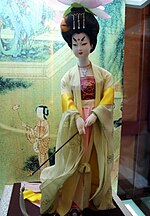Daxiushan
| Daxiushan | |||
|---|---|---|---|
 The clothing that the figure wears, depicts Tang dynasty Daxiushan (大袖衫), taken in Xi'an Shaanxi History Museum. | |||
| Chinese | 大袖衫 | ||
| Literal meaning | "large sleeved robe" or "large sleeved gown" or "large sleeved shirt" or "broad sleeved robe" or "broad sleeved garment" | ||
| |||
Daxiushan (Chinese: 大袖衫; lit. 'large-sleeved gown'[1]), also referred as dian chai li yi (Chinese: 钿钗礼衣),[2] dashan (Chinese: 大衫; lit. 'Large shirt'), daxiu (Chinese: 大袖; lit. 'Big sleeves'),[3] is a traditional Chinese article of clothing for women and was most popular during the Tang Dynasty, particularly amongst the Royals.[4][5] The clothing was mainly worn for special ceremonial occasions and had different variations, mainly the result of different collar formations (e.g., parallel or cross collar or those with no collar).[2][1] It could be worn under the skirt or as an outerwear.[1] After the Tang dynasty, it continued to be worn in the Song and Ming dynasties.[1][6]
Terminology[]
It has come to be known as Da-Xiu-Shan but has also been called Dian-Chai-Li-Yi (钿钗礼衣) at various times.[2] It was also referred as dashan and daxiu in the Ming dynasty.[3]
History[]
Tang dynasty and Five dynasties and Ten Kingdoms[]
After the golden age of the Tang Dynasty ended, the influence of Hufu (胡服), or clothing styles from Central and Western Asia, gradually weakened and Tang royal women's clothing styles began to make their transformation becoming more and more broader and looser.[4][7][1]
It was not until the Mid-Late Tang period (中晚唐时期) that the distinctions between Royal women's clothing and other styles became increasingly obvious.[2]

Paintings of women wearing Daxiushan during the Tang Dynasty

Paintings of women wearing Daxiushan during the Tang Dynasty

A late Tang dynasty Buddhist donatress.

Buddhist donatress Chang, Mo-kao Caves, Five dynasties and Ten Kingdoms.

Red daxiushan, Late Tang or Five dynasties and Ten Kingdoms period
Song dynasty[]
Broad sleeved garment was originally worn by empresses and imperials concubines as their ordinary clothing.[1] However, it was later adopted by the aristocratic women who used it as part of their ceremonial attire.[1] Commoners were not allowed to wear the broad sleeved garment and had to wear the beizi instead.[1]

Buddhist donors, early Northern Sung dynasty, 983 AD

Unearthed artefact of a broad-sleeved garment of the Southern Song dynasty.[8]
Ming dynasty[]
The Ming dynasty daxiushan was worn by the titled court women of first rank.[6]
Construction and Design[]
Tang dynasty daxiushan[]
The width of the coat increased to more than four feet and its sleeves were often wider than 1.3 metres.[2][9][1] It features a distinctive gown that covers the body from the ground to just above the chest with a knot wrapped around the waist, a light and sometimes sheer outer coat that ties together at the bottom, near the knees, and often goes along with a long scarf draped around the arms. The clothing often only covers half of women's breast and so it is restricted to women of a certain status, such as princesses or gējī.[2]
Similar garments[]
See also[]
References[]
- ^ a b c d e f g h i 5000 years of Chinese costumes. Xun Zhou, Chunming Gao, 周汛, Shanghai Shi xi qu xue xiao. Zhongguo fu zhuang shi yan jiu zu. San Francisco, CA: China Books & Periodicals. 1987. pp. 94–95, 115–118. ISBN 0-8351-1822-3. OCLC 19814728.
{{cite book}}: CS1 maint: others (link) - ^ a b c d e f "唐·服饰" 慢束罗裙半露胸 “钿钗礼衣”大袖衫——唐代女子服 Archived 2011-07-07 at the Wayback Machine wenhua.eco.gov.cn retrieved 2010-01-07
- ^ a b "What is Hezi Qun - Origins and Types - 2021". www.newhanfu.com. Retrieved 2021-12-23.
- ^ a b 唐代大袖衫 Archived 2011-07-07 at the Wayback Machine yonglian.gov.cn retrieved 2010-01-07
- ^ Sullivan, Lawrence R. (2021). Historical dictionary of Chinese culture. Nancy Liu-Sullivan. Lanham, Maryland: Rowman & Littlefield Publishers. p. 173. ISBN 978-1-5381-4604-0. OCLC 1233321993.
- ^ a b "Daesam(大衫)". Encyclopedia of Korean Folk Culture. Archived from the original on 2021-12-22.
- ^ "Woman's costume in the Tang Dynasty". www.chinadaily.com.cn. Retrieved 2021-04-09.
- ^ 5000 years of Chinese costumes. Xun Zhou, Chunming Gao, 周汛, Shanghai Shi xi qu xue xiao. Zhongguo fu zhuang shi yan jiu zu. San Francisco, CA: China Books & Periodicals. 1987. p. 118. ISBN 0-8351-1822-3. OCLC 19814728.
{{cite book}}: CS1 maint: others (link) - ^ Zang, Yingchun; 臧迎春. (2003). Zhongguo chuan tong fu shi. 李竹润., 王德华., 顾映晨. (Di 1 ban ed.). Beijing: Wu zhou chuan bo chu ban she. ISBN 7-5085-0279-5. OCLC 55895164.
- Chinese traditional clothing
- Clothing stubs
- China stubs






